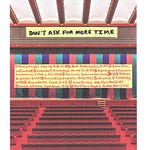Here is the track list for 26 Reformations of a Middle Class American Heart, Vol. 8: Let This Happy Thought See You Through, which I completed in early November 2022 over the Thanksgiving holiday.
Side A:
Ween, Birthday Boy (3:31)
Half Japanese, Secret (2:16)
Railroad Jerk, In My Face (3:03)
Thee Headcoats, Rusty Hook (2:10)
Fastbacks, Better Than Before (3:37)
The Bevis Frond, Good Old Fashioned Pain (2:59)
Sun City Girls, The Shining Path (3:03)
Sonic Boom, Angel (7:53)
Flaming Lips, Five Stop Mother Superior Rain (6:19)
Vic Chesnutt, Soft Picasso (3:30)
The Field Mice, Canada (3:27)
Mazzy Star, Before I Sleep (2:10)
Love Positions, Into Your Arms (1:38)
Side B:
Codeine, D (4:29)
Galaxie 500, Fourth of July (5:37)
McCarthy, I Worked Myself Up From Nothing (3:40)
The Bats, Other Side of You (3:08)
The Sundays, I Kicked a Boy (2:17)
Brian Eno & John Cale, Spinning Away (5:29)
The Darkside, Found Love (2:53)
The Clean, Dunes (3:01)
Robyn Hitchcock, Queen Elvis (4:24)
Ruth’s Refrigerator, He Needs a Dog (2:17)
Les Enfants Terribles, Paths of Glory (3:39)
The Queers, I Met Her At the Rat (3:13)
Jody & The Creams, Blue Moon (2:08)
By 1990 indie music and alternative music were more clearly distinguishable from one another. Nirvana, Pearl Jam and the million bands that followed in their wake (Candlebox, anyone?) made those differences as noticeable as could be a year later, though other alternative commercial successes like R.E.M. and U2 had already made them pretty clear both musically and status-wise. Alternative music, to put it one way that remains pretty durable, sought an audience and a market while indie music borrowed the punk rock perspective that audiences were for sellouts who had abandoned their scenes. And that’s another thing — indie music happened in local scenes, as detailed in many places, including the book, Our Band Could Be Your Life. It spread via tapes, tours, and small radio shows, not via MTV and mainstream radio. It sounded like it, too, as captured to some degree on Vol. 5 of this series.
Naturally, it was much more complicated than that simple divide and ordering of principles. With this being my historical trilogy’s installation focused on the genre’s golden era, I’ve chosen with that in mind to foreground a more omnivorous, less purist-pleasing perspective on the reach of indie music in 1990. I came to understand that this was the case with indie music at the time by listening to 600 albums from that year — doing so forced me to confront my idealized version of the past of indie music, and to recognize that it wasn’t all about scenes and tapes and tours. It was also about capable bands playing interesting music in studios, or about industry veterans messing around in lo-fi situations.
Thus, this mixtape includes true indie bands like Half Japanese and Sun City Girls — home tapers and lifetime outsider artists respectively — and also songs by Sonic Boom, The Sundays, and John Cale/Brian Eno, each of whom attained a measure, at minimum, of mainstream success at some point in their careers. The mixtape’s first draft (I labored on this one for nearly a month) even included a Pet Shop Boys song. Here as well are a song by a suburban pop-punk band and another from the album that more or less defined slowcore, one of the many indie rock subgenres coming into form around this time.
Regardless of what it does in terms of defining indie music in 1990, I straight up love this mixtape. In my opinion, it does everything an indie music mixtape can reasonably do in 90 minutes. It covers all the variety, provides excellent songs both reasonably and completely unknown, and gives equal space to big and random names. It could be better — there are truly great indie songs from 1990 that I didn’t include for many reasons — but I couldn’t make it better myself.















Share this post